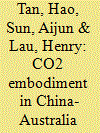|
|
|
Sort Order |
|
|
|
Items / Page
|
|
|
|
|
|
|
| Srl | Item |
| 1 |
ID:
125634


|
|
|
|
|
| Publication |
2013.
|
| Summary/Abstract |
This study focuses on CO2 emissions 'embodied' in the characteristic China-Australia bilateral trade, which refer to the CO2 emissions due to the production of goods traded between the two countries. We perform an assessment of the CO2 embodiment in the trade during the period between 2002 and 2010. We find that the scale effect has been a dominant effect contributing to an increase of CO2 emissions embodied in the bilateral trade through the years; while the composition effect seems to be a major driver for reducing CO2 embodiment in the exports of Australia to China. Based on an analysis of the difference between the amounts of actual CO2 embodiment and those in a hypothetical 'no-trade' scenario, we estimate that the 'net' CO2 emissions due to the bilateral trade declined from around 10 Mt of CO2 emissions in 2002 to -10 Mt in 2010; that is, the bilateral trade contributed to a reduction of the global carbon emissions in the recent years. This finding suggests that the rapid growth of exports of carbon-intensive goods from Australia to China has helped in reducing carbon emissions globally because carbon intensity factors of those goods are much lower in Australia than those in China.
|
|
|
|
|
|
|
|
|
|
|
|
|
|
|
|
| 2 |
ID:
109345


|
|
|
|
|
| Publication |
2011.
|
| Summary/Abstract |
It has been argued by some that the substitution of biofuels for gasoline could increase greenhouse gas (GHG) emissions, rather than reduce them. The increase is attributed to the indirect land use change effects of planting new grain and corn crops around the world to replace those progressively being devoted to ethanol production. In this paper, indirect effects are minimised by allowing land to be used for both food and fuel, rather than for one or the other. We present a sugarcane 'feed+fuel' biorefinery, which produces bioethanol and yeast biomass, a source of single-cell protein (SCP), that can be used as a high-protein animal feed supplement. The yeast SCP can partially substitute for grass in the feed of cattle grazing on pasture and thereby potentially release land for increased sugarcane production, with minimal land use change effects. Applying the concept conservatively to the Brazilian ethanol and livestock industry our model demonstrates that it would be technically feasible to raise ethanol production threefold from the current level of 27 GL to over 92 GL. The extra ethanol would meet biofuel market mandates in the US without bringing any extra land into agricultural or pastoral use. The analysis demonstrates a viable way to increase biofuel and food production by linking two value chains as called for by industrial ecology studies.
|
|
|
|
|
|
|
|
|
|
|
|
|
|
|
|
| 3 |
ID:
177377


|
|
|
|
|
| Summary/Abstract |
Phasing out the use of coal for power generation is an important concern for energy policy in the context of green transition. Despite the efforts of other nations, the role of China in the global phase-out of coal power remains crucial. Our study with a sub-national focus sheds important new light on the drivers and decision-making dynamics of exiting of coal power use in China. Based on a case study of closures of coal power plants in China's Guangdong province, we find that under certain circumstances, governments - especially those in the provincial and city levels - can and do act as change agents when it comes to retirement of coal fired power stations. Our study reveals a number of push and pull mechanisms that governments have utilized to overcome the resistance of incumbent power generation companies, primarily based on developmental considerations. By identifying the drivers and enabling mechanisms of phasing out the use of coal power in a significant sub-national region in China, our study contributes to both of the sustainability transition literature and the energy policy literature.
|
|
|
|
|
|
|
|
|
|
|
|
|
|
|
|
| 4 |
ID:
117235


|
|
|
|
|
| Publication |
2013.
|
| Summary/Abstract |
China's industrial transformation of the past thirty years, when its GDP has been increasing by an average of 10% per year, has been underpinned by an energy industrial revolution. Electrical energy is the driver of this transformation, with China utilizing latecomer advantages in building an electrical energy generation machine of prodigious size. In terms of electrical energy generated, China's system has expanded twelve-fold in 30 years, from 280 TWh in 1980 to over 3500 TWh in 2010. In this paper we describe the principal features of this remarkable transformation, examining the official projections to 2020, the semi-official projections to 2050, and offering our own projections based on observed logistic industrial dynamics for the uptake of renewable energies as well as the continuing role to be played by fossil fuels, particularly coal. We emphasize the role to be played by China's construction of a 'strong and smart' electric power grid, as envisaged in the 12th Five Year Plan released in March 2011, and the complementary proposals to build a national high speed rail system. We see China as on track to phase out fossil fuels altogether in its power production system by the end of the century. We develop an argument as to why it might be expected that fossil fuel utilization will decline while renewable energy utilization might increase in China, constituting a genuine energy industrial revolution.
|
|
|
|
|
|
|
|
|
|
|
|
|
|
|
|
|
|
|
|
|